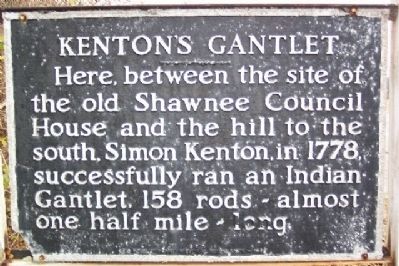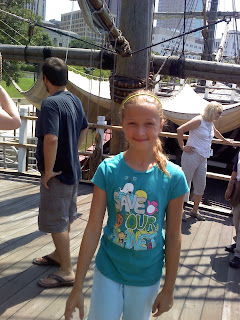 |
| the first settlement happened right here 11/18/1788 |
Cincinnati folks learn that their city was founded in 1788. There are signs around the perimeter of the city on the different highways that seem to confirm this.
There was actually no such thing as a community called "Cincinnati" until 1790. It also wasn't incorporated as a village until 1802 and not incorporated as a city until 1819. Let me explain.
After the Revolutionary War formally ended with the signing of the
Treaty of Paris in 1783, the US Congress established 260,000 square miles called the
Northwest Territory in July 1787 which was previously under British rule. This paved the way to establish the modern states of Ohio, Indiana, Illinois, Michigan, Wisconsin, and Minnesota in the 19th century.
John Cleves Symmes came along and purchased a chunk of this land between the two Miami rivers, had it surveyed, and began reselling it to potential settlers. Out of these land sales, 3 settlements along the Ohio River were established:
 |
| Stites has a nice grave marker in Columbia |
Columbia was the first settlement by a man named
Benjamin Stites and 26 settlers on
November 18th, 1788.
Columbia was a Romanesque term widely used then to refer to America and American things in the early days and was, of course, derived from the name of Christopher Columbus. Stites had been to the area previously while pursuing Indian raiders who had stolen horses in Kentucky. He decided to purchase land from Symmes when it became available. This settlement was on the Ohio River at the mouth of the Little Miami River near where present-day
Lunken Airport is located. This original settlement was destroyed by flooding and the subject of frequent Indian attacks. Today, the "East End" is one of modern Cincinnati's oldest neighborhoods called
Columbia-Tusculum with 3000 people. Benjamin, along with many of the other original settlers is buried near the original landing in a cemetery across from Lunken.
 |
| Cincinnatus gets a statue at Yeatman's Cove |
The second settlement, Losantiville, was about a month later on
December 28th, 1788. Colonel Robert Patterson and Israel Ludlow and their party arrived at a spot a few miles up from the Little Miami on the Ohio River at the mouth of the Licking River. This is near present-day
Yeatman’s Cove in downtown Cincinnati. The expedition was financed by
Mathias Denman. This is the date and place that is credited with the founding of modern Cincinnati.
John Filson, who surveyed this area earlier in 1788, created the name Losantiville which meant
"the city opposite the mouth of the Licking River" from the following:
"L" for the Licking River in KY on the other side of the Ohio.
"os" from the Latin for mouth.
"anti" from the Greek for opposite.
"ville" which was French for city.
Filson actually disappeared earlier in 1788 near Losantiville during a survey. No one really knows what happened to him and his body was never found. He may have been captured by Shawnee or he may have gotten lost and died in the wilderness. Either is plausible since Filson really wasn't much of a frontiersman and more of an historian and bureaucrat.
Now for some Cincinnati related Daniel Boone trivia!...It was Filson's mostly factual
1784 "Adventures of Colonel Daniel Boone" that made Boone one of America's best known legendary folk heroes and made him famous worldwide. It was also Daniel Carter Beard's 1905
"Sons of Daniel Boone", founded in Cincinnati, that became the modern-day Boy Scouts. The I-471
yellow "Big Mac Bridge" bridge that crosses the Ohio near Yeatman's Cove is officially named for Beard.
 |
| Symmes got a nice sign near his grave |
The third settlement, North Bend, was
February 2nd, 1789 a few miles East of present-day Cincinnati near the mouth of the Great Miami on the Ohio River and was the town that
John Cleves Symmes himself started.
It was named so because it was the most northern bend in the Ohio River. This was the settlement that Symmes thought would become the most successful but it turned out that the area, like Columbia, was prone to constant flooding and not sustainable. This area did later became the home of
future President William Henry Harrison who married Symmes daughter Anna but this area did not grow as much as Symmes had hoped.
Harrison's Tomb is here as well. The grave of father-in-law John Cleves Symmes is adjacent to the tomb.
North Bend remains today as a small 1.2 sq mi village of about 600 residents.
 |
| Ft Washington Marker near Lytle Park |
Besides the flooding, what really made the second settlement of
Losantiville take off was the 1789 addition of
Fort Washington by
Northwest Territory Governor Gen. Arthur St. Clair near present-day 3rd & Broadway. This certainly made would be settlers feel a bit safer.
St. Clair wanted to make that area the seat of the territorial government but he didn't like the name Losantiville and renamed the new city to
Cincinnati in 1790. There really wasn't much objection to this as it was the now dead Filson who came up with Losantiville anyway.
It is an often repeated falsity that Cincinnati was named directly for the Roman farmer turned leader turned farmer
Lucius Quinctius Cincinnatus. St. Clair actually named the city after the club of Revolutionary War veterans he was president of called the
Society of the Cincinnati that honored George Washington. The members saw Washington as a modern day Cincinnatus. This, of course, pleased his friends and his boss George Washington, very very much. In 1791, after St Clair lost a major battle to the Indians at
St Clairs Defeat, Washington fired him from the Army but let him remain as Governor of the Northwest Territory. Several years later, over political differences about the territory, after 15 years as Governor, President Jefferson fired him in 1802 and Ohio became our 17th State in 1803
or the 49th in 1953. I find it ironic that a man who presided over a club nobly named for a farmer turned leader turned farmer had no intention of doing so himself. Politicians always have like the "do as I say not as I do" motto.
 |
| St Clair got a rock at a busy intersection |
So, while the area which grew to become known as Cincinnati was formally settled in 1788 there were actually earlier settlements in the area (such as the
1785 Fort Finney near North Bend) but it was not officially called Cincinnati for 2 more years until 1790 when a gouty fat cat governor by the name of Arthur St. Clair tried to impress his boss and his friends. That's probably too much to fit on a sign on I-75.









































